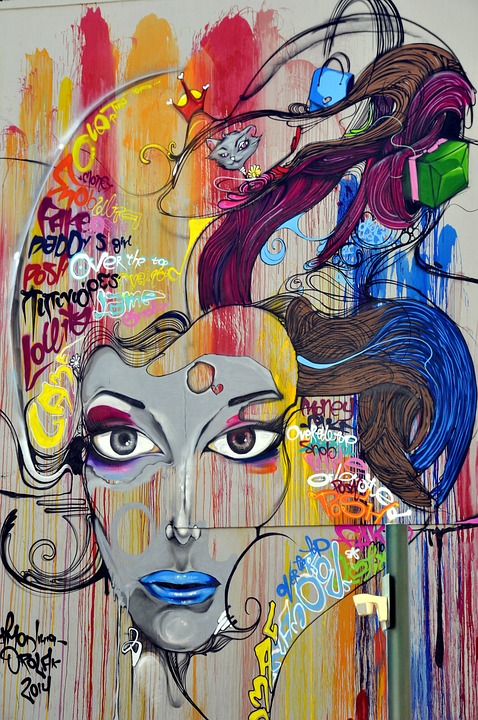The Birth of Street Art
Street art has a long and storied history dating back to ancient civilizations. From the graffiti found in the ruins of Pompeii to the murals painted on the walls of Egyptian tombs, humans have been using public spaces to express themselves for centuries. However, it wasn’t until the 1960s and 70s that street art as we know it today truly began to take shape.
The Rise of Graffiti
It all started in the streets of New York City, where teenagers began tagging their names and symbols on walls, subway cars, and any other available surface. These early graffiti artists, or “writers,” sought to make their mark on the city and claim their own little piece of urban real estate. While many viewed graffiti as vandalism, others saw it as a form of self-expression and rebellion against the mainstream art world.
The Influence of Hip-Hop
The explosion of hip-hop culture in the 1980s had a significant impact on the evolution of street art. Graffiti artists began incorporating elements of rap music, breakdancing, and DJing into their work, creating a vibrant and dynamic art form that reflected the energy and creativity of the streets.
The Shift Towards Acceptance
Despite its roots in rebellion and vandalism, street art has gradually been embraced by mainstream culture in recent years. Galleries and museums now host exhibitions of street art, and cities around the world commission murals from renowned street artists. So, how did street art make the transition from underground subculture to mainstream acceptance?
The Power of Social Media
One of the key factors driving the acceptance of street art is the rise of social media. Platforms like Instagram, Facebook, and Twitter have enabled artists to share their work with a global audience, bypassing traditional gatekeepers like galleries and museums. Street artists can now connect directly with their fans and build a following online, leading to increased recognition and opportunities for collaboration.
The Influence of Banksy
The enigmatic street artist known as Banksy has played a significant role in popularizing street art and bringing it to a wider audience. With his politically charged stencils and clever commentary on contemporary society, Banksy has garnered a massive following and mainstream recognition. His subversive works have been celebrated in galleries, museums, and even auction houses, blurring the line between street art and fine art.
The Impact of Street Art on Urban Spaces
Beyond its cultural significance, street art has also had a profound impact on the urban landscape. Murals and installations by street artists can transform drab and neglected spaces into vibrant and engaging works of art, revitalizing neighborhoods and sparking conversations among residents. Street art has the power to challenge preconceived notions, provoke thought, and inspire positive change in communities.
The Role of Street Art in Social Justice Movements
Many street artists use their work as a tool for social activism, addressing issues such as inequality, racism, and environmental degradation. Street art has been at the forefront of movements like Black Lives Matter and Extinction Rebellion, serving as a visual and powerful form of protest. By bringing these important issues to the forefront, street artists can amplify marginalized voices and spark conversations that lead to positive change.
The Economic Impact of Street Art Tourism
The growing popularity of street art has also had economic implications for cities around the world. Tourists flock to destinations like Berlin, London, and New York City to see famous street art pieces and explore vibrant neighborhoods filled with murals and installations. This influx of visitors can boost local economies, supporting small businesses and creating jobs in the tourism sector. Cities are beginning to recognize the value of street art as a cultural and economic asset, leading to increased support and funding for public art projects.
The Future of Street Art
As street art continues to evolve and gain mainstream acceptance, its future remains bright and full of possibilities. New technologies like augmented reality and virtual reality are offering street artists exciting new tools to push the boundaries of their creativity. Street art festivals and residencies are providing artists with opportunities to collaborate and showcase their work on a global stage.
The Importance of Preserving Street Art
Despite its ephemeral nature, street art deserves to be preserved and celebrated as a vital part of our cultural heritage. Organizations like the Street Art Preservation Society and the Mural Arts Program are working to document and protect street art pieces from destruction or decay. By recognizing the value of street art and supporting its preservation, we can ensure that future generations will be able to enjoy and learn from these powerful and thought-provoking works of art.
In conclusion, the evolution of street art from vandalism to acceptance is a testament to the power of art to transcend boundaries and bring people together. Street art has the ability to challenge, inspire, and transform urban spaces, making our cities more vibrant and inclusive. As street art continues to evolve and grow, we can look forward to a future filled with creativity, collaboration, and positive change.
